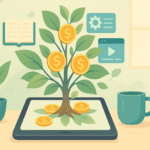Freelancers’ Guide to Creating and Selling Digital Products
Welcome to the world of freelancing, where creativity meets flexibility! 🌟 Are you ready to dive into the realm of digital products? Whether you’re a seasoned freelancer or just embarking on this exciting journey, creating and selling digital products can be a rewarding way to enhance your income. In this guide, we’ll walk you through the process step-by-step, ensuring you have all the tools you need to succeed. Let’s get started!
Table of Contents
1. Introduction
2. Why Digital Products?
3. Identifying Your Niche
4. Creating Your Digital Product
5. Selling Your Digital Product
6. Marketing Strategies
7. Conclusion
8. FAQs
Introduction
In today’s digital age, the demand for online products is skyrocketing. From eBooks and online courses to graphic templates and software, digital products offer freelancers an incredible opportunity to showcase their expertise and creativity. The best part? They require minimal overhead and can generate passive income over time. Let’s explore how you can tap into this lucrative market.
Why Digital Products?
Digital products are a fantastic choice for freelancers for several reasons:
1. Low Overhead Costs: Unlike physical products, digital products require little to no inventory or shipping costs. This means you can focus more on creation and less on logistics.
2. Scalability: Once a digital product is created, it can be sold an unlimited number of times without additional costs, allowing you to scale your business effortlessly.
3. Flexibility: You can create digital products in various formats and subjects, catering to different audiences and expanding your reach.
Identifying Your Niche
Before creating your digital product, it’s crucial to identify your niche. This involves understanding your interests, expertise, and market demand. Here are some tips to help you find your niche:
1. Assess Your Skills: Consider what you’re passionate about and where your strengths lie. Are you a graphic designer, writer, or software developer? Your skills can guide you in selecting the right digital product to create.
2. Research Market Demand: Use tools like Google Trends, keyword research tools, and online forums to gauge what potential buyers are interested in. Look for gaps in the market that you can fill.
3. Analyze Competitors: Study successful digital products in your chosen niche. Identify what makes them popular and think about how you can offer something unique.
Creating Your Digital Product
Once you’ve identified your niche, it’s time to start creating! Here are the key steps to develop a high-quality digital product:
1. Plan Your Content: Outline your product’s structure and content. Whether you’re writing an eBook or developing software, having a clear plan will keep you organized.
2. Use the Right Tools: Invest in reliable software and tools that will help you create professional-grade products. For example, use design software for graphics or e-learning platforms for online courses.
3. Quality Assurance: Ensure your product is polished and free of errors. Consider hiring a professional editor or tester to review your work.
Selling Your Digital Product
With your digital product ready, it’s time to get it into the hands of your audience. Here are some tips for selling successfully:
1. Choose the Right Platform: Decide whether to sell on your own website or use third-party platforms like Etsy, Gumroad, or Amazon. Each has its pros and cons, so choose the one that aligns with your goals.
2. Set a Competitive Price: Research competitor pricing and determine a price point that reflects your product’s value while remaining competitive.
3. Offer Free Samples: Provide potential customers with a sneak peek or free sample of your product. This can entice them to make a purchase.
Marketing Strategies
Effective marketing is key to the success of your digital product. Here are some strategies to consider:
1. Utilize Social Media: Leverage platforms like Instagram, Twitter, and LinkedIn to promote your product. Engage with your audience and share behind-the-scenes content.
2. Email Marketing: Build an email list and send newsletters to keep your audience informed about new products, discounts, and updates.
3. Collaborate with Influencers: Partner with influencers or bloggers in your niche to reach a broader audience and gain credibility.
Conclusion
Creating and selling digital products as a freelancer is an exciting and potentially lucrative venture. By identifying your niche, crafting a quality product, and implementing effective marketing strategies, you can tap into a growing market and establish a successful income stream. Remember, the key to success lies in understanding your audience and continually refining your offerings. Happy creating! 🎉
FAQs
Q: What types of digital products can freelancers create?
A: Freelancers can create a variety of digital products, including eBooks, online courses, design templates, music, photography, software, and more.
Q: How do I price my digital product?
A: Research competitor pricing and consider factors like production costs, perceived value, and market demand to set a competitive price.
Q: Can I sell digital products without a website?
A: Yes, you can sell on platforms like Etsy, Gumroad, or Amazon without needing your own website, though having one can help build your brand.
Q: How do I protect my digital products from unauthorized distribution?
A: Use digital rights management (DRM) tools and include terms of use to protect your products. Additionally, monitor online platforms for unauthorized distribution.
Free Download!
Best Digital Product – eBooks, templates, AI tools, courses, and mor






